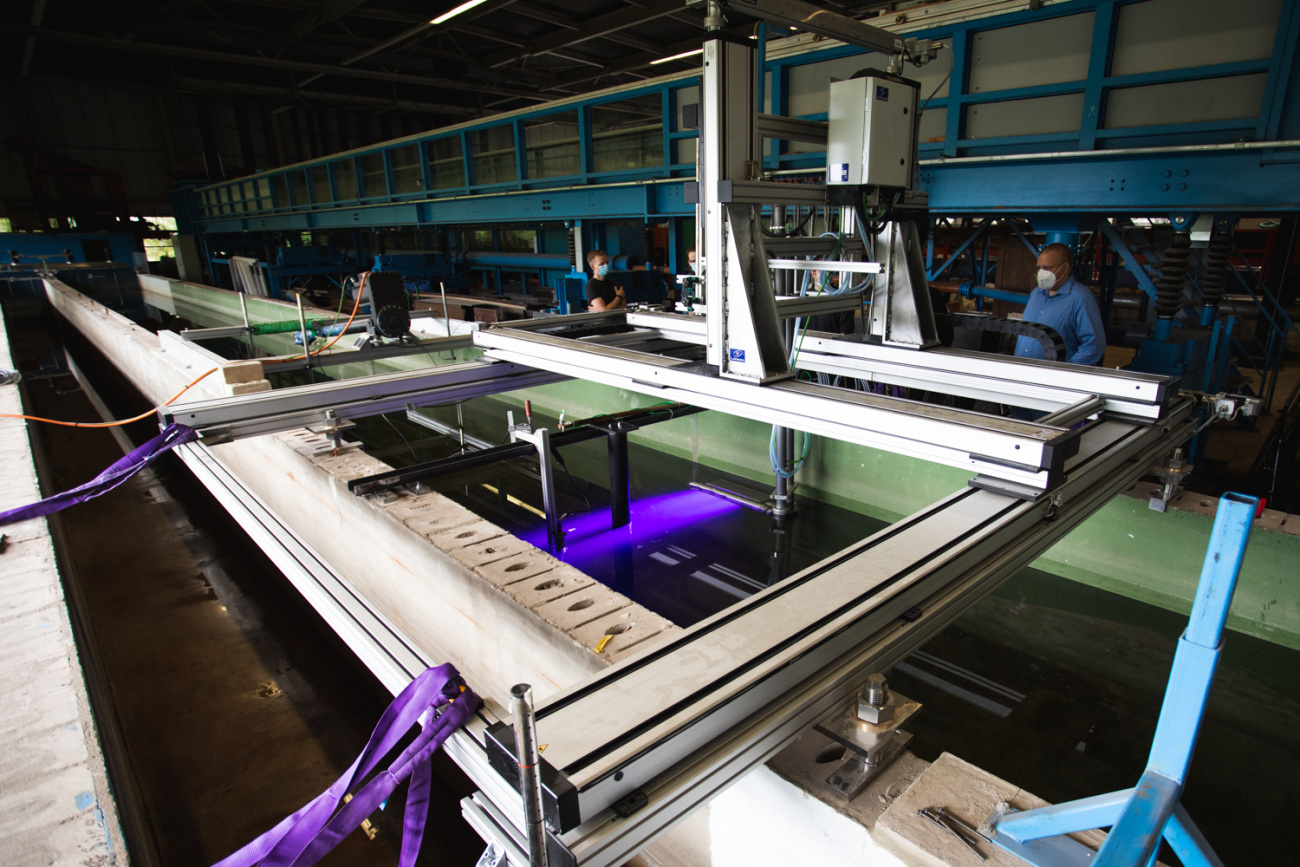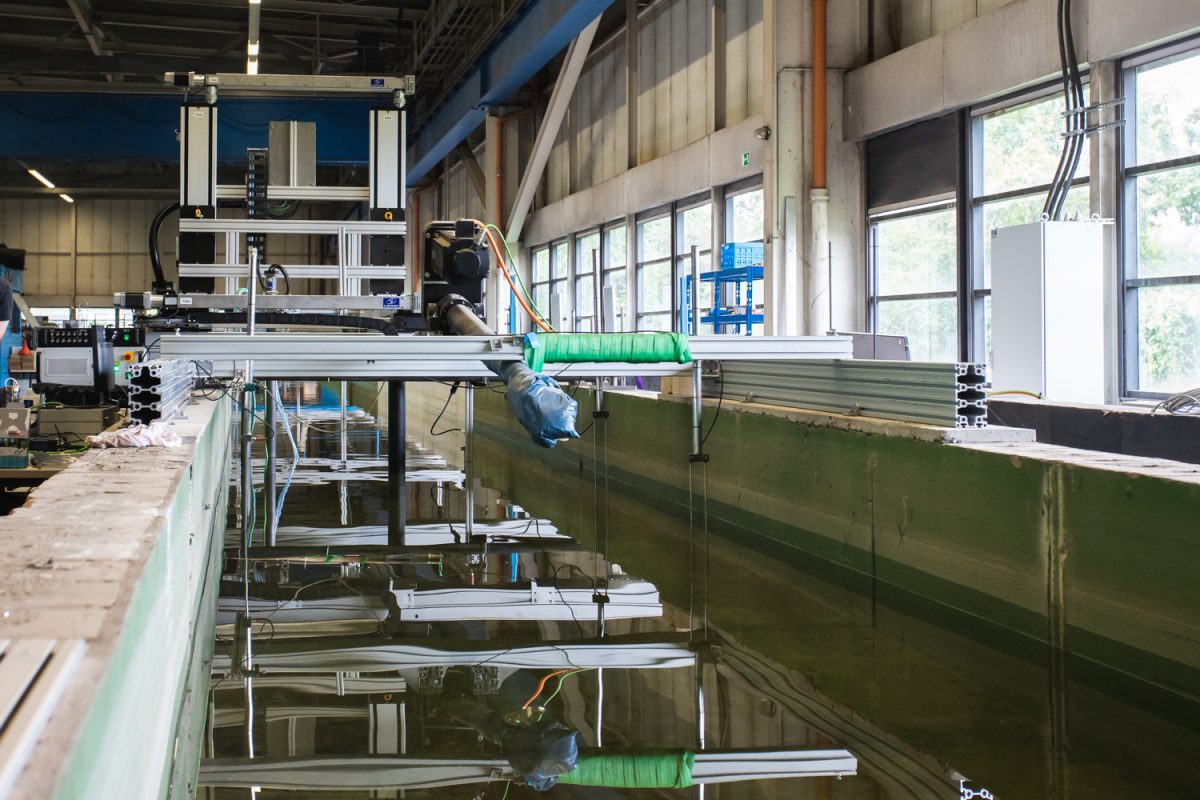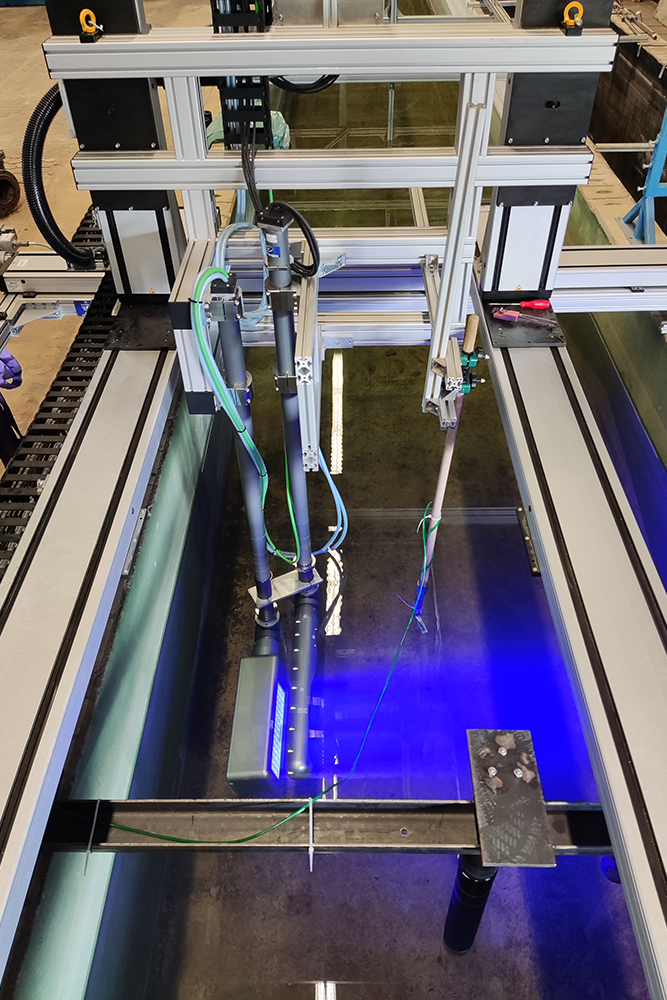Inspection and Data Collection

Time to Read: 4m 0s
The "EnviSim4Mare" research project was formed to investigate how the growth of mussels, algae and other small sea creatures influences the load-bearing capacity of offshore wind turbines and other maritime structures. For this purpose, a new saltwater-capable large-scale research facility is being built at the Leichtweiß Institute for Hydraulic Engineering (LWI).
Offshore wind turbines are exposed to extreme forces from waves, wind and ocean currents. In addition, mussels and algae collect on these structures and influence the load capacity of the structures. Scientists from the (LWI) are investigating the effects of this growth in the "EnviSim4Mare" research project.
The Problem
The team was in need of accurate, reliable, and precise measuring methods capable of recording and measuring the flows around the underwater structure.
“EmviSim4Mare” Project Uses Technologically Advanced Isel Cartesian Robots
The "EnviSim4Mare" research project was formed to investigate how the growth of mussels, algae and other small sea creatures influences the load-bearing capacity of offshore wind turbines and other maritime structures. For this purpose, a new saltwater-capable large-scale research facility is being built at the Leichtweiß Institute for Hydraulic Engineering (LWI).
Offshore wind turbines are exposed to extreme forces from waves, wind and ocean currents. In addition, mussels and algae collect on these structures and influence the load capacity of the structures. Scientists from the (LWI) are investigating the effects of this growth in the "EnviSim4Mare" research project.
The Problem
The team was in need of accurate, reliable, and precise measuring methods capable of recording and measuring the flows around the underwater structure.
The Solution
LWI called upon Isel Automation engineers to develop a rodless ball screw linear actuator Cartesian Robot capable of recording the flow tests for the "EnviSim4Mare" project.
The Results
The well-engineered and precision manufactured rodless linear ball screw actuators provided by Isel Automation have proven to be more than capable of meeting the demands of the project as well as supplying reliable data.
 |
| Isel LES 5 ball screw linear actuators used to move the cameras. Photo credits: Max Fuhrmann/TU Braunschweig |
Isel’s Ball Screw Linear Actuator Cartesian Robots
The essence of the "EnviSim4Mare" project is to assist in protecting offshore wind turbines that are exposed to the extreme forces from waves, wind, and ocean currents. Mussels and algae collect on the turbines and influence their load capacity. Isel Automation’s ball screw linear actuator Cartesian Robots are used to measure the force of the flow.
LWI scientists are investigating the effects of the growths as part of the "EnviSim4Mare" research project and are using Isel Automation Cartesian Robot positioning systems, that have multiple linear actuators, to measure the effects of the flows around underwater structures.
Perfect Cartesian Robot Positioning System
The Isel Automation Cartesian Robot positioning system is the perfect tool for the “EnviSim4Mare” project since its work cycle, along the XY table, can be easily visualized and defined. The rodless ball screw actuators have two guiding rails that move along the XY table making them capable of handling lateral forces and provide defined straightness. Isel Automation’s ball screw linear actuators have excellent reliability and accuracy, which is required by the project.
A Shake-The-Box 4D-PTV system was set up on a wave channel in the LWI's test hall. A camera arm, four cameras, and LEDs are attached the 4D-PTV and weigh around 800 kilograms at an expense of approximately 300,000 euros.
The Shake-The-Box 4D-PTV is a highly sophisticated and complex technical system capable of producing precise measurements. In the first few weeks of the project, Mario Welzel and Clemens Krautwald were busy getting to know the device.
"We therefore planned a little more time in the run-up to the first tests," says Mario Welzel, research associate in the "EnviSim4Mare" project. "We have to make numerous settings on the 4D-PTV system for the measurements."
 |
| Four cameras and LEDs are attached to the construction of Isel Automation LES 5 ball screw linear actuators, which weighs around 800 kilograms. Picture credits Max Fuhrmann/TU Braunschweig |
Linear Actuator Cartesian Robots & Piles with "Fur"
In the initial phases of the project, the wave channel and poles around which the current is measured by the linear actuator Cartesian Robots had to be prepared. The scientists want to test 18 different shafts per post and prepared eight posts.
Some of the posts were painted black while others were covered with sandpapers of different grits or have received a "fur" that has been made from carpeting of several lengths. The piles of the carpeting vary between smooth to fluffy to simulate the foundational structures of offshore wind turbines and various types of vegetation.
The water in the wave channel washes around the posts. The first wave slowly rolls towards the black painted pole. A wide purple stripe from the meter's LEDs illuminates above the channel.
As the waves flow around the poles, Mario Welzel and Clemens Krautwald have watched intently. Tiny particles are visible following in the smooth orbital motion of the waves or in turbulence caused by the pile surfaces.
Welzel and Krautwald distributed thousands of plastic beads in the measuring area around the poles in order to use them to study the velocity fields of the waves and around the structures.
"With the 4D flow field measurement, we can measure the flow without influencing it as with other methods," says Welzel.
They observed and analyzed the processes from a distance using optical means. Welzel and Krautwald vary the waves and use different stakes in the canal.
 |
| Multiple Isel LES 5 ball screw linear actuators in inspection and data colletion application. Photo credits: Max Fuhrmann/TU Braunschweig |
Using Isel’s Linear Actuator Cartesian Robots in Experiments
The focus of the "EnviSim4Mare" is on the effects of force, shedding vortices, and flow patterns. Due to the different roughness of the “fur” or carpet piles, the force measured by the linear actuator Cartesian Robots acting on the structure’s changes, which means that the growth of mussels and algae must be taken into account during the planning and construction of wind turbines.
“We need a better understanding of the system here. Because the less we know about the processes and influences, the more safety factors have to be built in,” explains Welzel.
“In addition to the piles of the huge, firmly anchored wind turbines, cables and pipelines are also affected by mussel growth”, adds Clemens Krautwald. “These basic tests of different piles are intended to improve understanding of the process, which is necessary in several areas.”
Close to 400 experiments, with different camera settings, were planned for the experiment. When the new saltwater wave flow channel is in the test hall in the coming year, the measuring device with the Isel Automation Cartesian Robot system and its ball screw linear actuators will be moved to the new location in order to continue the tests.
Isel’s Linear Actuators Durability in Applications
The dependability of the Isel Automation rodless ball screw actuators will be tested under the most severe conditions, conditions that Isel Automation engineers have prepared and constructed the linear actuators to meet.
The project team has deployed test bodies at various offshore locations in the North Sea around Heligoland and Nordergründe. Algae, barnacles and mussels will settle there in order to examine them in the completed research facility at the LWI.
EnviSim4Mare Project Funding
The "EnviSim4Mare" project has been funded since December 2019 by the Federal Ministry for Economic Affairs and Energy (BMWi). The Leichtweiß Institute of the TU Braunschweig, Department of Hydromechanics, Coastal Engineering, and Maritime Engineering will receive around 4 million euros from the funding for the sub-project.
In addition to the Leichtweiß Institute, the research network also includes the work of Professor Bela H. Buck from the Alfred Wegener Institute Helmholtz Center for Polar and Marine Research (AWI) in Bremerhaven, Jörss-Blunck-Ordemann GmbH, and Ocean Breeze Energy GmbH & Co. KG as well as other industrial partners and authorities.


